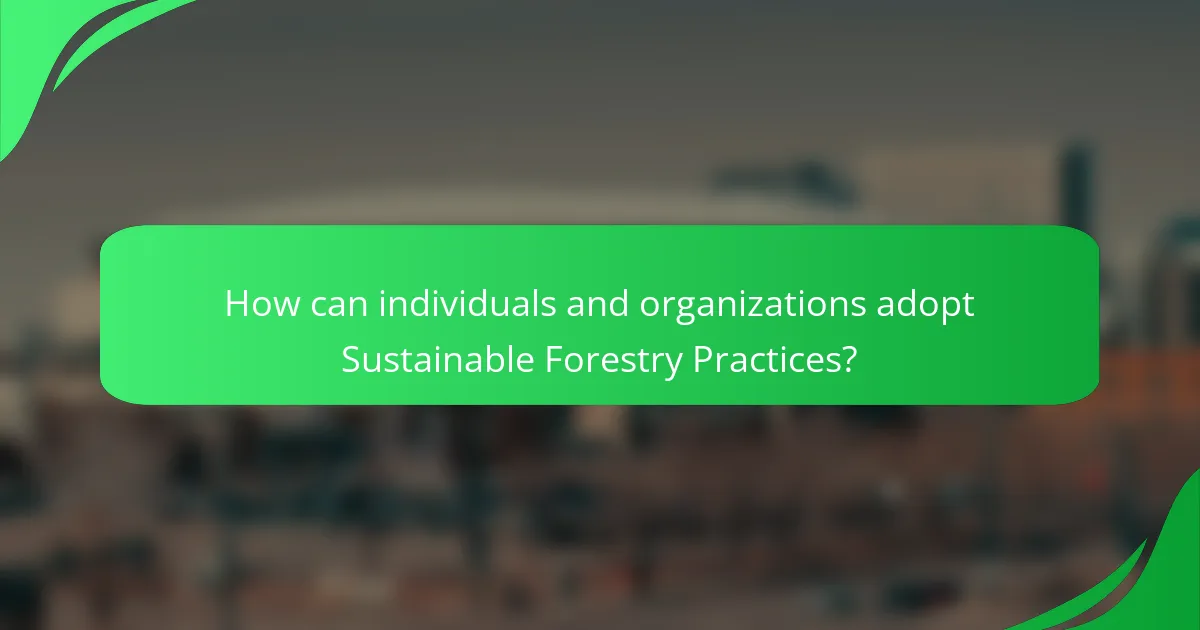Sustainable forestry practices are methods aimed at managing forest resources responsibly to meet present needs while preserving them for future generations. These practices include techniques such as selective logging, reforestation, and the conservation of wildlife habitats, all of which contribute to maintaining ecological balance and biodiversity. The article outlines the environmental benefits of sustainable forestry, including enhanced carbon sequestration, improved water quality, and reduced soil erosion. It also emphasizes the role of certification programs in promoting responsible management and the importance of community engagement in fostering sustainable livelihoods. Through these practices, sustainable forestry not only supports forest health but also aids in climate change mitigation and economic stability for local communities.

What are Sustainable Forestry Practices?
Sustainable forestry practices are methods of managing forest resources to meet current needs without compromising future generations. These practices focus on maintaining ecological balance and biodiversity. Techniques include selective logging, reforestation, and maintaining wildlife habitats. Sustainable forestry also emphasizes the use of non-timber forest products. According to the Forest Stewardship Council, responsible management can enhance forest health. Studies show that sustainable practices can increase carbon storage in forests. This approach contributes to climate change mitigation and supports local economies.
How do Sustainable Forestry Practices differ from traditional methods?
Sustainable forestry practices prioritize ecological balance while traditional methods focus on maximizing timber production. Sustainable practices include selective logging, which minimizes habitat disruption. This contrasts with clear-cutting, often used in traditional methods, leading to soil erosion and biodiversity loss. Sustainable methods also emphasize reforestation and afforestation, ensuring forest regeneration. In contrast, traditional methods may neglect these processes, resulting in deforestation. Additionally, sustainable forestry incorporates community engagement and fair labor practices. Traditional methods often overlook social responsibility, focusing solely on profit. Research indicates that sustainable forestry can enhance carbon sequestration, improving climate resilience. This evidence supports the effectiveness of sustainable practices in promoting long-term forest health.
What are the key principles of Sustainable Forestry Practices?
Key principles of sustainable forestry practices include maintaining biodiversity, ensuring forest health, and managing resources responsibly. Biodiversity is crucial as it supports ecosystem resilience and productivity. Forest health involves monitoring and mitigating threats such as pests and diseases. Responsible resource management ensures that timber harvesting does not exceed regeneration rates. Sustainable practices also emphasize the importance of community engagement and stakeholder participation. These principles aim to balance ecological, economic, and social needs for future generations. Evidence from various studies shows that forests managed sustainably can provide long-term economic benefits while preserving environmental integrity.
How is sustainability measured in forestry?
Sustainability in forestry is measured through various indicators and criteria. These include the assessment of forest health, biodiversity, and ecosystem services. Metrics such as tree growth rates and regeneration success are used to evaluate forest productivity. Additionally, the impact on local communities and the economy is considered. Compliance with certification standards like FSC (Forest Stewardship Council) also indicates sustainable practices. Monitoring carbon sequestration rates provides insight into climate impact. Regular audits and assessments ensure adherence to sustainability goals. Collectively, these measures help maintain ecological balance while supporting economic viability.
Why are Sustainable Forestry Practices important?
Sustainable forestry practices are important because they ensure the long-term health of forest ecosystems. These practices help maintain biodiversity by protecting various plant and animal species. They also prevent deforestation, which is crucial for combating climate change. Sustainable methods reduce soil erosion and improve water quality. According to the Food and Agriculture Organization, sustainable forestry can enhance carbon storage in forests. This contributes to climate mitigation efforts. Furthermore, these practices support local communities by providing jobs and resources. They promote a balanced approach to resource management, ensuring forests can regenerate naturally.
What role do they play in biodiversity conservation?
Sustainable forestry practices play a crucial role in biodiversity conservation. They help maintain diverse ecosystems by promoting the growth of various tree species. This diversity supports a wide range of wildlife habitats. Sustainable practices also reduce deforestation, which is a major threat to biodiversity. For example, selective logging minimizes habitat destruction compared to clear-cutting. Additionally, sustainable forestry often includes the preservation of buffer zones. These zones protect water sources and provide corridors for wildlife movement. Research indicates that forests managed sustainably can support higher biodiversity levels than those subjected to conventional logging.
How do they contribute to climate change mitigation?
Sustainable forestry practices contribute to climate change mitigation by enhancing carbon sequestration. These practices promote the growth of trees, which absorb carbon dioxide from the atmosphere. According to the Food and Agriculture Organization, forests store approximately 289 gigatons of carbon globally. Sustainable management reduces deforestation, preserving existing carbon stocks. Additionally, these practices improve forest health, increasing resilience to climate impacts. Research indicates that well-managed forests can sequester up to 1.1 billion tons of carbon annually. By maintaining biodiversity, sustainable forestry supports ecosystems that further mitigate climate change effects.

What are the Environmental Benefits of Sustainable Forestry Practices?
Sustainable forestry practices provide significant environmental benefits. They enhance biodiversity by maintaining diverse ecosystems. These practices help in carbon sequestration, reducing greenhouse gas emissions. Sustainable forestry also prevents soil erosion, preserving soil health. Water quality is improved through reduced runoff and sedimentation. Additionally, sustainable methods promote the regeneration of forests, ensuring long-term forest health. According to the Forest Stewardship Council, certified sustainable practices lead to healthier forests and ecosystems.
How do Sustainable Forestry Practices improve soil health?
Sustainable forestry practices improve soil health by enhancing soil structure and fertility. These practices include selective logging, reduced soil disturbance, and maintaining forest cover. Selective logging minimizes damage to surrounding trees and soil, preserving the ecosystem. Reduced soil disturbance prevents erosion and compaction, which can degrade soil quality. Maintaining forest cover protects the soil from harsh weather conditions and promotes moisture retention. Furthermore, sustainable practices increase organic matter through decomposing plant material. This organic matter enriches the soil, supporting microbial activity essential for nutrient cycling. Research indicates that forests managed sustainably can have up to 30% higher soil organic carbon levels compared to unsustainably managed forests.
What practices are used to enhance soil quality?
Practices used to enhance soil quality include cover cropping, crop rotation, and reduced tillage. Cover cropping involves planting specific crops to protect and enrich the soil during off-seasons. This practice prevents erosion and improves soil structure. Crop rotation alternates different crops in the same area across seasons. It helps break pest and disease cycles while enhancing nutrient availability. Reduced tillage minimizes soil disturbance, preserving soil structure and moisture. These methods promote healthy soil ecosystems. Research shows that these practices can increase organic matter content by up to 30% over time.
How do these practices affect water quality and availability?
Sustainable forestry practices positively affect water quality and availability. These practices include selective logging, reforestation, and maintaining buffer zones around water bodies. Selective logging reduces soil erosion, which minimizes sedimentation in waterways. Reforestation enhances groundwater recharge by increasing soil permeability. Buffer zones help filter pollutants before they reach water sources. Studies show that forests can improve water quality by up to 50% in treated watersheds. Sustainable practices also ensure a consistent water supply by maintaining the natural hydrological cycle. This leads to healthier ecosystems and supports biodiversity. Overall, sustainable forestry practices contribute to both improved water quality and reliable water availability.
What impact do Sustainable Forestry Practices have on wildlife?
Sustainable forestry practices positively impact wildlife by preserving habitats and maintaining biodiversity. These practices promote the responsible management of forest resources. They reduce habitat destruction by minimizing clear-cutting and allowing for selective logging. This approach maintains the structure of the forest ecosystem, providing shelter and food for various species. Research indicates that forests managed sustainably support higher populations of birds and mammals compared to those that are not. A study by the World Wildlife Fund found that sustainable forestry can enhance habitat connectivity, allowing wildlife to thrive. Overall, sustainable forestry practices contribute to the health and stability of wildlife populations.
Which species benefit from these practices?
Many species benefit from sustainable forestry practices. Forest ecosystems support a wide range of wildlife. Birds, mammals, and insects thrive in well-managed forests. For example, the northern spotted owl relies on old-growth forests for habitat. Additionally, species like the red fox and white-tailed deer find food and shelter in sustainably managed areas. Sustainable practices also promote biodiversity, which benefits many plant and animal species. Research shows that these practices can enhance species richness and ecosystem resilience. Therefore, sustainable forestry positively impacts numerous species within forest ecosystems.
How do these practices create habitats for diverse ecosystems?
Sustainable forestry practices create habitats for diverse ecosystems by maintaining forest structure and biodiversity. These practices include selective logging, which allows for the preservation of mature trees and understory plants. By avoiding clear-cutting, sustainable forestry protects soil health and water quality. This approach supports various wildlife species by providing shelter and food sources. Additionally, practices like reforestation enhance habitat connectivity, allowing species to migrate and thrive. Studies show that forests managed sustainably can support 30% more wildlife than those subjected to conventional logging methods. This evidence underscores the effectiveness of sustainable forestry in fostering rich ecosystems.

How can individuals and organizations adopt Sustainable Forestry Practices?
Individuals and organizations can adopt sustainable forestry practices by implementing responsible management techniques. These techniques include selective logging, which minimizes environmental impact while promoting forest regeneration. Establishing protected areas within forests helps conserve biodiversity and ecosystems. Utilizing certification programs, such as FSC or PEFC, ensures adherence to sustainable practices. Engaging in reforestation efforts replenishes tree populations and enhances carbon sequestration. Collaborating with local communities fosters sustainable livelihoods and encourages conservation. Monitoring and assessing forest health regularly helps identify and mitigate potential threats. These practices collectively contribute to long-term ecological balance and resource sustainability.
What steps can be taken to implement Sustainable Forestry Practices?
To implement sustainable forestry practices, organizations must adopt several key steps. First, they should conduct thorough assessments of forest resources. This includes evaluating biodiversity, soil quality, and water resources. Second, developing a management plan is essential. This plan should outline practices that promote regeneration and protect ecosystems. Third, implementing selective logging techniques can minimize environmental impact. These techniques help maintain forest structure and biodiversity. Fourth, reforestation and afforestation efforts are necessary. Planting native species supports local ecosystems and enhances carbon sequestration. Fifth, engaging with local communities ensures that forestry practices align with social and economic needs. Finally, monitoring and adapting practices based on ecological feedback is crucial. Continuous assessment helps improve sustainability outcomes over time. These steps collectively contribute to the long-term health of forest ecosystems.
What resources are available for learning about sustainable forestry?
Resources for learning about sustainable forestry include online courses, academic journals, and government publications. Websites like Coursera and edX offer courses on sustainable forestry practices. The Journal of Forestry and Forest Ecology and Management publish peer-reviewed research articles. The USDA Forest Service provides guides and reports on sustainable practices. Nonprofit organizations like the Forest Stewardship Council offer resources and certification information. Books such as “Sustainable Forestry: From Theory to Practice” provide in-depth knowledge. Additionally, local universities often have extension programs focused on forestry education. These resources ensure comprehensive learning about sustainable forestry.
What best practices should be followed in sustainable forestry?
Best practices in sustainable forestry include selective logging, maintaining biodiversity, and implementing reforestation. Selective logging reduces environmental impact by allowing certain trees to remain while harvesting others. This method preserves the forest structure and habitat for wildlife. Maintaining biodiversity ensures the ecosystem remains resilient and functional. It involves protecting various species and their habitats. Implementing reforestation helps restore areas that have been logged or degraded. This practice contributes to carbon sequestration and soil stability. Additionally, using sustainable forest management plans can guide practices that balance ecological, economic, and social needs. These practices are supported by research indicating their effectiveness in promoting forest health and longevity.
How can technology enhance sustainable forestry efforts?
Technology enhances sustainable forestry efforts by improving monitoring, management, and conservation practices. Remote sensing technologies, such as satellite imagery, allow for real-time monitoring of forest health and deforestation rates. Drones can assess forest conditions and gather data on biodiversity efficiently. Geographic Information Systems (GIS) help in planning and managing forest resources effectively. Advanced data analytics enable better decision-making regarding resource allocation and conservation strategies. According to a study by the Food and Agriculture Organization (FAO), these technologies can significantly reduce illegal logging and promote reforestation efforts. The integration of technology in forestry leads to increased efficiency and sustainability in forest management practices.
What common challenges do practitioners face in sustainable forestry?
Practitioners in sustainable forestry face several common challenges. One significant challenge is balancing economic viability with environmental sustainability. This often leads to conflicts between short-term profit and long-term ecological health. Another challenge is the lack of comprehensive data on forest ecosystems. Inadequate information can hinder effective management decisions. Additionally, practitioners encounter regulatory complexities. Navigating various laws and policies can be time-consuming and confusing. Climate change also poses a significant challenge. It affects forest health and species distribution, complicating management strategies. Lastly, there is often insufficient community engagement. Without local support, sustainable initiatives may struggle to succeed.
What are the future trends in Sustainable Forestry Practices?
Future trends in sustainable forestry practices include increased use of technology and data analytics. Precision forestry, utilizing drones and satellite imagery, enhances monitoring and management. There is also a growing emphasis on biodiversity conservation within forestry operations. Practices such as agroforestry and mixed-species plantations are gaining traction. Climate change adaptation strategies are being integrated into forest management plans. Certification schemes like FSC and PEFC are becoming more prominent. Additionally, community-based forestry initiatives are on the rise, promoting local stewardship. These trends reflect a shift towards more resilient and sustainable forest ecosystems.
How is policy evolving to support sustainable forestry?
Policy is evolving to support sustainable forestry through stricter regulations and incentives. Governments are implementing frameworks that promote responsible forest management. These frameworks include certifications for sustainable practices. They encourage reforestation and afforestation initiatives. Financial incentives are being offered for maintaining biodiversity and ecosystem services. International agreements, such as the Paris Agreement, emphasize sustainable land use. Recent studies show that sustainable forestry can reduce carbon emissions significantly. For example, the Global Forest Resources Assessment reported that well-managed forests can sequester substantial amounts of CO2.
What innovations are emerging in sustainable forestry techniques?
Emerging innovations in sustainable forestry techniques include precision forestry, agroforestry, and the use of drones. Precision forestry utilizes data analytics and remote sensing to optimize resource management. This approach enhances productivity while minimizing environmental impact. Agroforestry integrates trees and shrubs into agricultural landscapes, promoting biodiversity and soil health. Drones are increasingly used for monitoring forest health and assessing tree growth. They provide real-time data that supports informed decision-making. Additionally, advancements in bioengineering are leading to the development of tree varieties that are more resilient to climate change. These innovations collectively contribute to more sustainable forest management practices.
Sustainable forestry practices are methods aimed at managing forest resources to fulfill present needs while ensuring future ecological balance and biodiversity. This article outlines the differences between sustainable and traditional forestry methods, emphasizing principles such as biodiversity maintenance, responsible resource management, and community engagement. It further explores the environmental benefits of sustainable practices, including improved soil health, water quality, and wildlife habitats, as well as their role in climate change mitigation. The discussion also highlights the challenges faced by practitioners and emerging trends and innovations in sustainable forestry techniques.